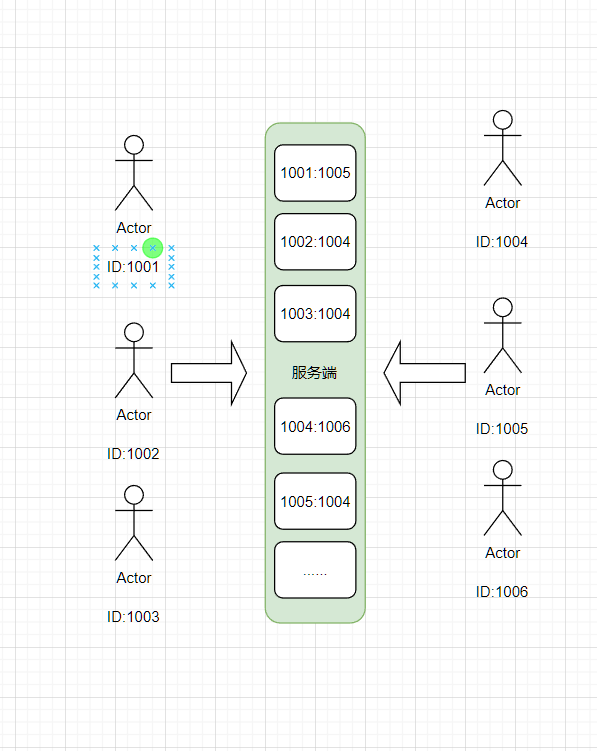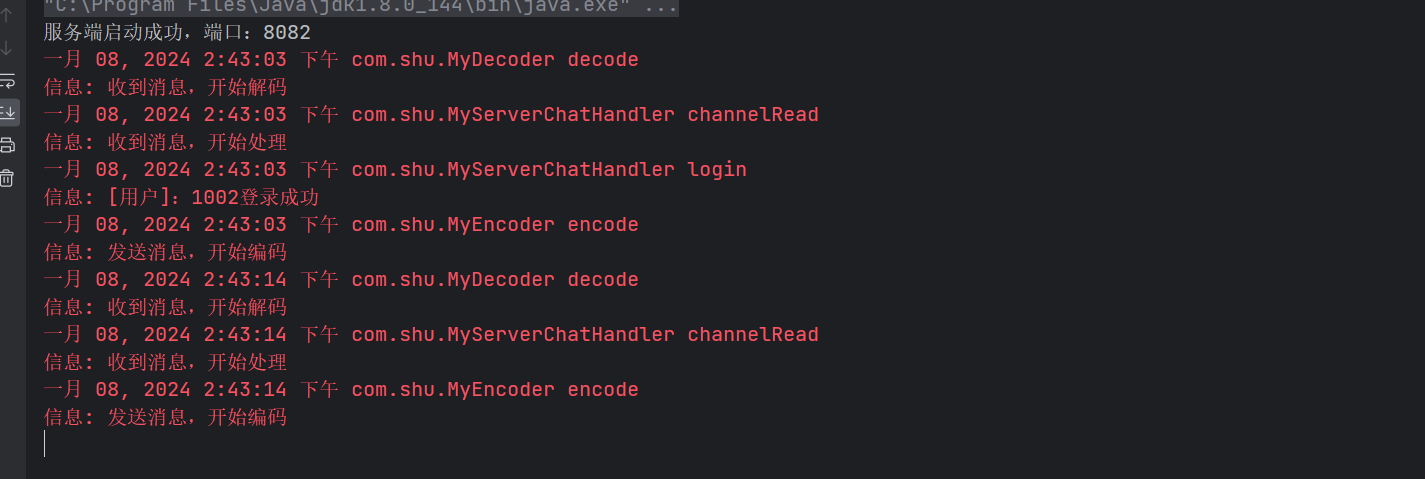Netty 实现单聊
1.1 思路分析
- 客户端01:表明自己的身份,属性(比如:我叫啥,我的身份证号码,姓名,住址等等)
- 服务端:验证客户端身份信息,保存客户端身份信息,保持登录状态,如果不在线,就无法接受信息
- 客户端02:表明自己的身份,属性(比如:我叫啥,我的身份证号码,姓名,住址等等),如果自身在服务端注册过,且有指定我的身份信息消息传递过来。就接受信息

1.2 分析
- 第一个点:序列化与反序列化(传输效率):对于实体对象的序列化和反序列化,推荐使用 Fastjson 框架去实现,而不是Netty官方示例所使用的对象流。
- 第二个点:通信协议实现(约定):客户端和服务端之间的数据通讯,我们是基于实体对象去交互的,这样数据格式更加的方便。
1.3 过程
登录主要是为了让用户 ID 和通道(就是Netty中的Channel,也即网络连接)进行绑定。
在登录成功之后为 Channel 通过 attr() 方法绑定该用户 ID,主要目的有三个:
- 1)客户端A在发送消息时,服务端可以通过 Channel 获取消息发送者的用户ID,以便知道消息是“谁”发过来的;
- 2)服务端在收到客户端A发过来的消息时,通过消息中的接收者用户ID,可以获取接收者的Channel,以便知道消息该发给“谁”;
- 3)在 Channel 断开的时候,服务端可以监听到 Channel,并且获取 Channel 的属性,从而删除对应的用户ID和Chennel映射关系。
对于业务处理来说,用户登录和消息发送是两个不同的业务点,一般来说需要定义多个 Handler 来分别处理,但是这里为了减少 Handler 的数量,统一一个 Handler 处理。
1.4 实现
1.4.1 实体类
- 基础实体类
package com.shu.model;
import lombok.Data;
import java.io.Serializable;
/**
* @description: 基础bean
* @author: shu
* @createDate: 2024/1/5 9:36
* @version: 1.0
*/
@Data
public abstract class BaseBean implements Serializable {
/**
* 协议标识:ox66
*/
private Integer tag=0x66;
/**
* 业务指令
*
* @return
*/
public abstract Byte code();
}
- 登录请求:表明自己的的身份
package com.shu.model;
import lombok.Data;
import java.io.Serializable;
/**
* @description:
* @author: shu
* @createDate: 2024/1/5 9:38
* @version: 1.0
*/
@Data
public class LoginReqBean extends BaseBean implements Serializable {
/**
* 用户id
*/
private Integer userId;
/**
* 用户名
*/
private String userName;
/**
* 业务抽象方法
*
* @return
*/
@Override
public Byte code() {
return 1;
}
}
- 登录响应:服务器给客户端的确定登录信息,表明服务端收到了的客户端的信息
package com.shu.model;
import lombok.Data;
import java.io.Serializable;
/**
* @description:
* @author: shu
* @createDate: 2024/1/5 9:45
* @version: 1.0
*/
@Data
public class LoginResBean extends BaseBean implements Serializable {
private Integer status;//响应状态,0登录成功,1登录失败
private String msg;//响应信息
private Integer userid;//用户ID
/**
* 业务指令
*
* @return
*/
@Override
public Byte code() {
return 2;
}
}
- 消息发送请求:客户端需要发送给服务端的信息,需要给谁发信息
package com.shu.model;
import lombok.Data;
import java.io.Serializable;
/**
* @description:
* @author: shu
* @createDate: 2024/1/5 9:47
* @version: 1.0
*/
@Data
public class MsgReqBean extends BaseBean implements Serializable {
private Integer fromuserid;//发送人ID
private Integer touserid;//接受人ID
private String msg;//发送消息
/**
* 业务指令
*
* @return
*/
@Override
public Byte code() {
return 3;
}
}
- 服务端响应消息:服务器收到消息,并确定信息给客户端,可以通信,还是未登录信息
package com.shu.model;
import lombok.Data;
import java.io.Serializable;
/**
* @description: 消息响应bean
* @author: shu
* @createDate: 2024/1/5 10:53
* @version: 1.0
*/
@Data
public class MsgResBean extends BaseBean implements Serializable {
private Integer status;//响应状态,0发送成功,1发送失败
private String msg;//响应信息
/**
* 业务指令
*
* @return
*/
@Override
public Byte code() {
return 4;
}
}
- 客户端发送的消息
package com.shu.model;
import lombok.Data;
import java.io.Serializable;
/**
* @description:
* @author: shu
* @createDate: 2024/1/5 10:08
* @version: 1.0
*/
@Data
public class MsgRecBean extends BaseBean implements Serializable {
private Integer fromuserid;//发送人ID
private String msg;//消息
/**
* 业务指令
*
* @return
*/
@Override
public Byte code() {
return 5;
}
}
1.4.2 消息编解码
- 编码:比如将对象转换成二进制数据流
package com.shu;
import com.alibaba.fastjson.JSON;
import com.shu.model.BaseBean;
import io.netty.buffer.ByteBuf;
import io.netty.channel.ChannelHandlerContext;
import io.netty.handler.codec.MessageToByteEncoder;
import java.util.logging.Logger;
/**
* @description:
* @author: shu
* @createDate: 2024/1/5 10:32
* @version: 1.0
*/
public class MyEncoder extends MessageToByteEncoder<BaseBean> {
private static Logger logger = Logger.getLogger(MyEncoder.class.getName());
/**
* 编码器
* @param channelHandlerContext
* @param baseBean
* @param byteBuf
* @throws Exception
*/
@Override
protected void encode(ChannelHandlerContext channelHandlerContext, BaseBean baseBean, ByteBuf byteBuf) throws Exception {
logger.info("发送消息,开始编码");
//1.把实体序列化成字节数字
byte[] bytes= JSON.toJSONBytes(baseBean);
//2.根据协议组装数据
byteBuf.writeInt(baseBean.getTag());//标识(4个字节)
byteBuf.writeByte(baseBean.code());//指令(1个字节)
byteBuf.writeInt(bytes.length);//长度(4个字节)
byteBuf.writeBytes(bytes);//数据
}
}
- 解码:将二进制数据转换成对象,继续交给下一个处理器处理
package com.shu;
import com.alibaba.fastjson.JSON;
import io.netty.buffer.ByteBuf;
import io.netty.channel.ChannelHandlerContext;
import io.netty.handler.codec.ByteToMessageDecoder;
import com.shu.model.BaseBean;
import java.util.List;
import java.util.logging.Logger;
/**
* @description:
* @author: shu
* @createDate: 2024/1/5 10:48
* @version: 1.0
*/
public class MyDecoder extends ByteToMessageDecoder {
private static Logger logger = Logger.getLogger(MyDecoder.class.getName());
/**
* 解码器
* @param channelHandlerContext
* @param byteBuf
* @param list
* @throws Exception
*/
@Override
protected void decode(ChannelHandlerContext channelHandlerContext, ByteBuf byteBuf, List<Object> list) throws Exception {
logger.info("收到消息,开始解码");
//1.根据协议取出数据
int tag=byteBuf.readInt();//标识符
byte code=byteBuf.readByte();//获取指令
int len=byteBuf.readInt();//获取数据长度
byte[] bytes=new byte[len];
byteBuf.readBytes(bytes);
//2.根据code获取类型
Class<? extends BaseBean> c= MapUtils.getBean(code);
//3.反序列化
BaseBean baseBean= JSON.parseObject(bytes,c);
list.add(baseBean);
}
}
1.4.3 处理器
- 服务端处理器:接受不同的消息进行处理:登录验证,转发请求,验证身份等等
package com.shu;
import com.shu.model.*;
import io.netty.channel.Channel;
import io.netty.channel.ChannelHandlerContext;
import io.netty.channel.ChannelInboundHandlerAdapter;
import io.netty.util.AttributeKey;
import java.util.HashMap;
import java.util.Map;
import java.util.logging.Logger;
/**
* @description:
* @author: shu
* @createDate: 2024/1/5 11:02
* @version: 1.0
*/
public class MyServerChatHandler extends ChannelInboundHandlerAdapter {
//1.定义一个Map(key是用户ID,value是连接通道)
private static Map<Integer, Channel> map=new HashMap<Integer, Channel>();
private static Logger logger = Logger.getLogger(MyServerChatHandler.class.getName());
@Override
public void channelRead(ChannelHandlerContext ctx, Object msg) throws Exception {
logger.info("收到消息,开始处理");
if(msg instanceof LoginReqBean){
//1.登录请求
login((LoginReqBean) msg,ctx.channel());
}else if(msg instanceof MsgReqBean){
//2.发送消息请求
sendMsg((MsgReqBean)msg,ctx.channel());
}
}
//登录处理方法
private void login(LoginReqBean bean, Channel channel){
LoginResBean res=new LoginResBean();
//从map里面根据用户ID获取连接通道
Channel c=map.get(bean.getUserId());
if(c==null){
//通道为空,证明该用户没有在线
logger.info("[用户]:"+bean.getUserId()+"登录成功");
//1.添加到map
map.put(bean.getUserId(),channel);
//2.给通道赋值
channel.attr(AttributeKey.valueOf("userid")).set(bean.getUserId());
//3.响应
res.setStatus(0);
res.setMsg("登录成功");
res.setUserid(bean.getUserId());
channel.writeAndFlush(res);
}else{
//通道不为空,证明该用户已经在线了
res.setStatus(1);
res.setMsg("该账户目前在线");
channel.writeAndFlush(res);
}
}
//消息发送处理方法
private void sendMsg(MsgReqBean bean,Channel channel){
Integer touserid=bean.getTouserid();
Channel c=map.get(touserid);
if(c==null){
MsgResBean res=new MsgResBean();
res.setStatus(1);
res.setMsg(touserid+",不在线");
channel.writeAndFlush(res);
}else{
MsgRecBean res=new MsgRecBean();
res.setFromuserid(bean.getFromuserid());
res.setMsg(bean.getMsg());
c.writeAndFlush(res);
}
}
}
- 客户端处理器:根据不同的时机进行请求的处理,比如:建立连接处理,发送登录请求验证,收到服务端的消息进行处理
package com.shu;
import com.shu.model.*;
import io.netty.channel.Channel;
import io.netty.channel.ChannelHandlerContext;
import io.netty.channel.ChannelInboundHandlerAdapter;
import io.netty.util.AttributeKey;
import lombok.extern.slf4j.Slf4j;
import java.util.Scanner;
/**
* @description: 客户端处理器,用于处理客户端的请求和响应信息,继承ChannelInboundHandlerAdapter,重写channelRead方法,用于处理服务端响应的信息
* @author: shu
* @createDate: 2024/1/5 10:57
* @version: 1.0
*/
public class MyClientChatHandler extends ChannelInboundHandlerAdapter {
@Override
public void channelActive(ChannelHandlerContext ctx) throws Exception {
System.out.println(">>>>>>>>>>>>>>>>>>>>>>>>>>>>>>客户端通道就绪: 开始登录");
//通道就绪时,发起登录请求
login(ctx.channel());
}
@Override
public void channelRead(ChannelHandlerContext ctx, Object msg) throws Exception {
System.out.println(">>>>>>>>>>>>>>>>>>>>>>>>>>>>>>客户端收到消息 ");
//根据msg做类型判断,不同的业务做不同的处理
if(msg instanceof LoginResBean){
//1.登录结果响应
LoginResBean res=(LoginResBean) msg;
System.out.println(">>>>>>>>>>>>>>>>>>>>>>>>>>>>>>登录响应:"+res.getMsg());
if(res.getStatus()==0){
//1.登录成功,则给通道绑定属性
ctx.channel().attr(AttributeKey.valueOf("userid")).set(res.getUserid());
//2.调用发送消息方法
sendMsg(ctx.channel());
}else{
//1.登录失败,调用登录方法
login(ctx.channel());
}
}else if(msg instanceof MsgResBean){
//1.发送消息结果响应
MsgResBean res=(MsgResBean)msg;
System.out.println(">>>>>>>>>>>>>>>>>>>>>>>>>>>>>>发送响应:"+res.getMsg());
}else if(msg instanceof MsgRecBean){
//2.接受消息
MsgRecBean res=(MsgRecBean)msg;
System.out.println("fromuserid="+res.getFromuserid()+",msg="+res.getMsg());
}else {
System.out.println(">>>>>>>>>>>>>>>>>>>>>>>>>>>>>>未知响应");
}
}
//登录方法
private void login(Channel channel){
Scanner scanner=new Scanner(System.in);
System.out.println(">>用户ID:");
Integer userid=scanner.nextInt();
System.out.println(">>用户名称:");
String username=scanner.next();
LoginReqBean bean=new LoginReqBean();
bean.setUserId(userid);
bean.setUserName(username);
channel.writeAndFlush(bean);
}
//发送消息方法
private void sendMsg(final Channel channel){
final Scanner scanner=new Scanner(System.in);
new Thread(new Runnable() {
public void run() {
while (true){
System.out.println(">>接收人ID:");
Integer touserid=scanner.nextInt();
System.out.println(">>聊天内容:");
String msg=scanner.next();
MsgReqBean bean=new MsgReqBean();
//从通道属性获取发送人ID
Integer fromuserid=(Integer) channel.attr(
AttributeKey.valueOf("userid")
).get();
//发送人ID
bean.setFromuserid(fromuserid);
//接受人ID
bean.setTouserid(touserid);
//发送消息
bean.setMsg(msg);
channel.writeAndFlush(bean);
}
}
}).start();
}
}
注意顺序
- 整个的IO处理操作环节的前后两个环节,包括从通道读数据包和由通道发送到对端,由Netty的底层负责完成,不需要用户程序负责。
- 用户程序主要涉及的Handler环节为:数据包解码、业务处理、目标数据编码、把数据包写到通道中。

1.4.4 服务端与客户端
- 服务端
package com.shu;
import io.netty.bootstrap.ServerBootstrap;
import io.netty.channel.ChannelOption;
import io.netty.channel.nio.NioEventLoopGroup;
import io.netty.channel.socket.nio.NioServerSocketChannel;
import io.netty.handler.codec.LengthFieldBasedFrameDecoder;
/**
* @description:
* @author: shu
* @createDate: 2024/1/5 10:45
* @version: 1.0
*/
public class NettyServer {
// 端口
private int port;
// 服务器地址
private String host;
// Worker线程组
private NioEventLoopGroup workerGroup = new NioEventLoopGroup();
// Boss线程组
private NioEventLoopGroup bossGroup = new NioEventLoopGroup();
public NettyServer(String host, int port) {
this.port = port;
this.host = host;
}
/**
* 启动服务端
*
*/
public void start(){
try {
// 创建服务端
ServerBootstrap serverBootstrap = new ServerBootstrap();
// 设置线程组
serverBootstrap.group(bossGroup,workerGroup)
// 设置NIO通讯模式
.channel(NioServerSocketChannel.class)
// 设置缓冲区大小
.option(ChannelOption.SO_BACKLOG,1024)
// 设置数据处理器
.childHandler(new io.netty.channel.ChannelInitializer<io.netty.channel.socket.SocketChannel>() {
@Override
protected void initChannel(io.netty.channel.socket.SocketChannel socketChannel) throws Exception {
//1.拆包器
socketChannel.pipeline().addLast(new LengthFieldBasedFrameDecoder(Integer.MAX_VALUE,5,4));
//2.自定义解码器
socketChannel.pipeline().addLast(new MyDecoder());
//3.业务Handler
socketChannel.pipeline().addLast(new MyServerChatHandler());
//4.自定义编码器
socketChannel.pipeline().addLast(new MyEncoder());
}
});
// 启动服务端
io.netty.channel.ChannelFuture channelFuture = serverBootstrap.bind(host, port).sync();
System.out.println("服务端启动成功,端口:" + port);
// 监听关闭的channel,设置为同步方式
channelFuture.channel().closeFuture().sync();
} catch (InterruptedException e) {
e.printStackTrace();
}
}
}
- 客户端
package com.shu;
import io.netty.bootstrap.Bootstrap;
import io.netty.channel.ChannelFuture;
import io.netty.channel.ChannelInitializer;
import io.netty.channel.ChannelOption;
import io.netty.channel.nio.NioEventLoopGroup;
import io.netty.channel.socket.SocketChannel;
import io.netty.channel.socket.nio.NioSocketChannel;
import io.netty.handler.codec.LengthFieldBasedFrameDecoder;
/**
* @description:
* @author: shu
* @createDate: 2024/1/5 10:10
* @version: 1.0
*/
public class NettyClient {
/**
* 端口
*/
private int port;
/**
* 服务器地址
*/
private String host;
private NioEventLoopGroup group=new NioEventLoopGroup();
public NettyClient(String host, int port) {
this.port = port;
this.host = host;
}
/**
* 启动客户端连接服务器
*/
public void start() {
try {
// 创建客户端启动助手
Bootstrap bootstrap = new Bootstrap();
// 设置线程组
bootstrap.group(group)
// 设置NIO通讯模式
.channel(NioSocketChannel.class)
// 设置缓冲区大小
.option(ChannelOption.SO_BACKLOG, 1024)
// 设置数据处理器
.handler(new ChannelInitializer<SocketChannel>() {
@Override
protected void initChannel(SocketChannel socketChannel) throws Exception {
//1.拆包器
socketChannel.pipeline().addLast(new LengthFieldBasedFrameDecoder(Integer.MAX_VALUE,5,4));
//2.自定义解码器
socketChannel.pipeline().addLast(new MyDecoder());
//3.自定义业务
socketChannel.pipeline().addLast(new MyClientChatHandler());
//4.自定义编码器
socketChannel.pipeline().addLast(new MyEncoder());
}
});
// 连接服务器
ChannelFuture future = bootstrap.connect(host, port).sync();
System.out.println("客户端启动成功...");
// 等待连接关闭
future.channel().closeFuture().sync();
} catch (InterruptedException e) {
e.printStackTrace();
} finally {
// 优雅关闭线程组
group.shutdownGracefully();
}
}
/**
* 停止客户端
*/
public void stop() {
group.shutdownGracefully();
}
}
1.4.5 效果


总结
- 1)不同的业务可设置不同的实体和指令,需要把指令和实体的关系管理起来,方便反序列化的时候,可以根据指令来反序列化到具体实体;
- 2)需要把用户 ID 和通道的关系管理起来(方便根据用户ID找到Channel通道,反过来也一样),并且灵活运用 Channel 的 attr () 方法,该方法可以绑定属性值,非常的有用。